Skin Disorders: 5 Shots, 5 Tips
Here: Ted Rosen, MD, presents 5 tips about 5 skin disorders that you might not know.
Case 1
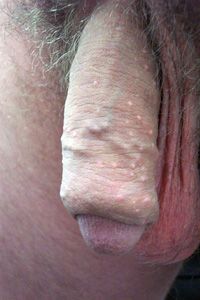
Young adult presents with a profusion of asymptomatic, small, umbilicated penile papules. He has had unprotected intercourse with many anonymous partners.
Key point: The globoid-shaped papules with central umbilication are typical for molluscum contagiosum, a pox virus infection spread by skin-to-skin contact.
Treatment: Sharp curettage removes lesions nicely. Light liquid nitrogen cryospray may also be efficacious in some patients. When surgical intervention is impractical, topical application of various irritants (such a tretinoin or salicylic acid) or immune modifiers (such as imiquimod) may be effective.
Note: The same disorder may occur in children, usually on the trunk or face. In this instance, the disease is not sexually transmitted. Treatment options are the same.
Case 2
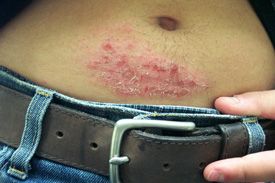
Teenage boy complains of an intensely pruritic patch on his abdomen. He has no similar lesions anywhere else.
Key point: The distinct localization suggests that the problem is due to something in close proximity. In fact, this is typical for true allergic contact dermatitis. The patient was found to be allergic to nickel, which is present in high concentrations in belt buckles and costume jewelry. Sweating leaches out the nickel from the metallic buckle onto the skin, eliciting an allergic reaction.
Treatment: A few days to a week of high potency topical steroid application and the troublesome spot will disappear.
Note:To prevent recurrence, the belt buckle can be coated with rhodium or simply discarded and replaced with a smaller one made of stainless steel.
Case 3
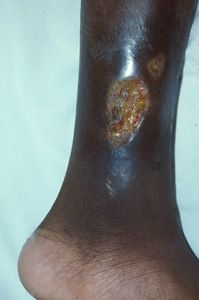
An 11-year-old boy presents with an extremely painful leg ulcer overlying the medial malleolus. He is known to have sickle cell disease.
Key point: Although rarely the presenting sign, leg ulcers are important, direct complications of sickle cell disease, occurring in about 8-10% of HbSS homozygotes in North America.
Treatment: Meticulous wound care and protection of the affected leg form trauma may suffice, although healing may take many months. For chronic ulcers (over 6 months duration), blood transfusion, skin grafting, Unna boot application, hyperbaric oxygen treatment, oral hydroxyurea or zinc sulfate, and use of topical platelet-derived growth factors may all be considered. Unfortunately, success or failure of these measures is based on anecdotal data; none of these interventions is guaranteed to be successful.
Note: In chronic, deep ulcers, osteomyelitis should be sought via bone scan and/or MRI. Prevention of trauma to the lower extremities may be partially protective.
Case 4
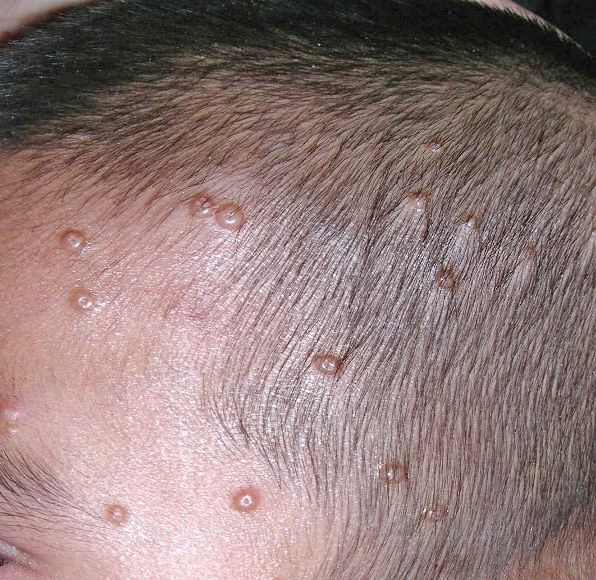
A 5-year-old boy presents with multiple, asymptomatic facial “bumps” of recent onset.
Key point: The globoid-shaped papules with central umbilication are typical for molluscum contagiosum, a pox virus infection spread by skin-to-skin contact.
Treatment: Sharp curettage removes lesions nicely. Light liquid nitrogen cryospray may also be efficacious in some patients. When surgical intervention is impractical, topical application of various irritants (such a tretinoin or salicylic acid) or immune modifiers (such as imiquimod) may be effective.
Note: The same disorder may occur in adults, usually in the genital region, as a sexually transmitted disease. Treatment options are the same.
Case 5
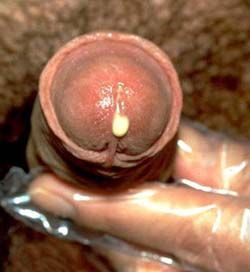
Sexually active young man presents with dysuria and profuse purulent urethral discharge.
Key point: Symptomatic, spontaneous purulent discharge is most typical of gonorrhea.
Treatment: Intramuscular ceftriaxone(Drug information on ceftriaxone) 250mg PLUS azithromycin(Drug information on azithromycin) or doxycycline(Drug information on doxycycline).
Note: Ciprofloxacin has recently been dropped as a recommended gonorrhea therapy due to high prevalent rates of resistance.
Recognize & Refer: Hemangiomas in pediatrics
July 17th 2019Contemporary Pediatrics sits down exclusively with Sheila Fallon Friedlander, MD, a professor dermatology and pediatrics, to discuss the one key condition for which she believes community pediatricians should be especially aware-hemangiomas.